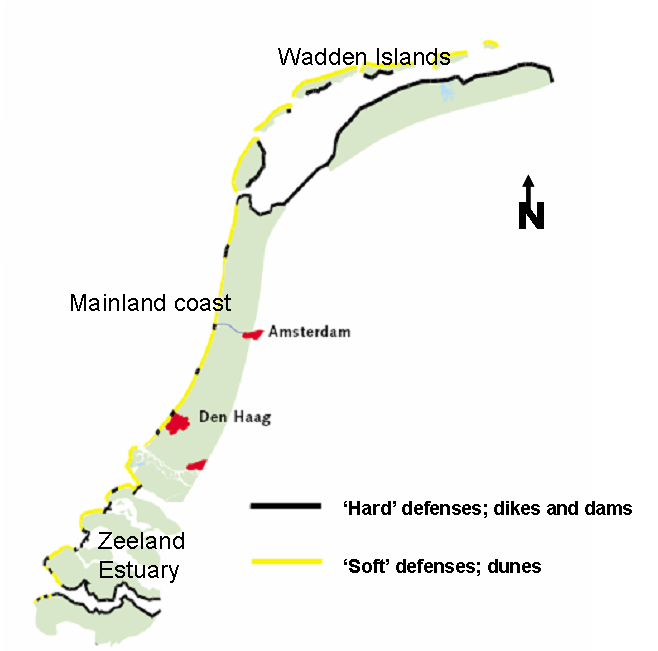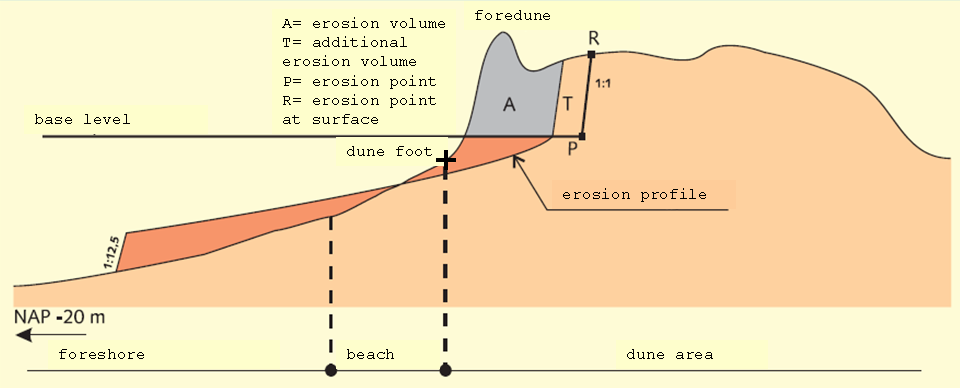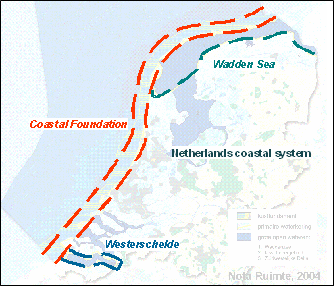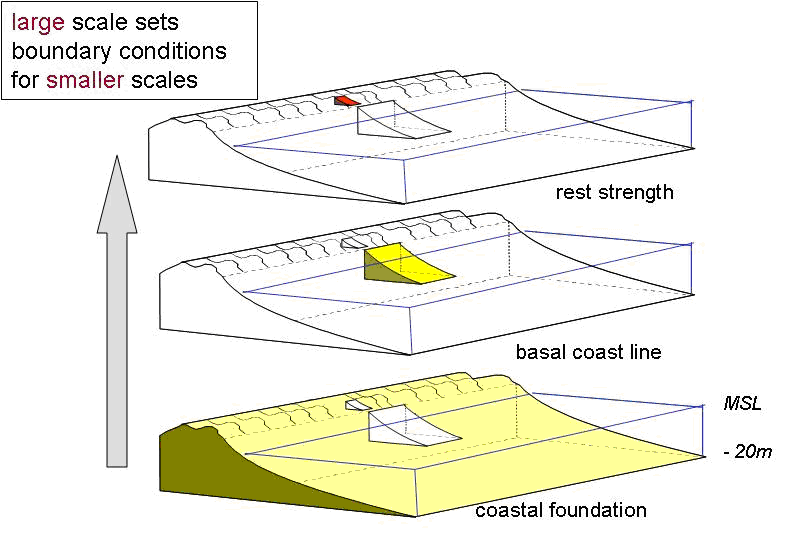Risk and coastal zone policy: example from the Netherlands
Risk and coastal zone policy: example from the Netherlands
Definition of risk
Various definitions of risk exist which can be applied to different situations and which often involve a degree of subjectivity. Roughly, divisions can be made between individual, societal, economic, environmental and technical risks (Bickerstaff, 2004). All known definitions of risk however have one element in common: the distinction between reality and possibility (Renn, 1998). A definition of risk contains three components, viz. (1) an outcome that has an impact on what humans value, (2) the possibility of occurrence (uncertainty) of an event and (3) a formula to combine both elements (Renn, 1998). In other words, risk can be described by a mathematical function of the probability of an event and the consequences of that event (Jonkman et al. 2003). In many cases, risk is defined as the probability of occurrence of a disaster (natural or man-induced) times the economic damage as a result of the disaster. Often, a cost-benefit analysis is carried out to determine the ‘acceptable’ risk level (Vrijling et al., 1998). The optimal risk level in a purely economic sense is determined by implementing measures in such a way that the total sum of the costs of risk reducing measures and the expected damage is minimized (RWS, 2005).
Often, the terms risk and uncertainty are used in the same context. There is however a clear distinction between risk and uncertainty. The term risk can be applied to describe situations for which probabilities are available to describe the likelihood of various events or outcomes. If probabilities of various events or outcomes cannot be quantified however, or if the events themselves are unpredictable, the term uncertainty can be applied (Loucks & Van Beek, 2005).
Risk in the coastal zone
In most coastal zones around the world, the risk of flooding poses a threat to present and future socio-economic activities. In this case risk can be defined as the probability of occurrence of an extreme event (storms, tsunamis) leading to erosion and flooding multiplied by the (socio-) economic damage caused by the storm event. It is important to note that in this case the probability itself does not necessarily involve risk. If the area prone to the effects of extreme events is free from any socio-economic activities, risk will be reduced to zero.
Risk and probability of extreme storms in the Netherlands
Dunes and dikes protect parts of the Netherlands which are situated below sea-level (see figure 1). The design levels of these flood defense structures are related to extreme storm surge water levels (which are related to the frequency of occurrence of an extreme storm event) (Loucks & Van Beek, 2005). Dunes and dikes along the Mainland coast (i.e. the provinces of Noord-Holland and Zuid-Holland) (figure 1) should be able to withstand the effects of a storm which has a probability of occurrence of once per 10.000 years. This roughly corresponds to a storm surge level of + 5 m Dutch Ordnance Level (NAP), which varies slightly along the coast. These storm surge water levels are called base levels. The base level is the general standard used to determine the minimum requirements which should be met by the flood defenses. The actual dimensions of the flood defenses however, also depend on hinterland characteristics. If a flood defense structure protects an area with a large economic value the design level of the flood defense should be higher than the base level. For the less dense populated parts along the Dutch coast, i.e. the province of Zeeland and the Wadden Islands (see figure 1), the design level is based on the frequency of occurrence of an extreme storm event of respectively once per 4000 years and once per 2000 years.
Figure 1. Flood defenses along the Dutch coast (Modified after:CPD, 2000)
Real estate landward of the sea defenses are protected by law via the so-called Flood Defense Act (Wet op de Waterkering) (1996). Those who work and live seaward of the sea defenses (in the ‘erosion zone’) do so at their own risk (RIKZ, 2002).
‘Soft’ sea defenses: dunes
The former Technical Advisory Committee for Flood Defenses (TAW, 1995) introduced a method to calculate dune erosion as a result of an extreme storm event and offered criteria to test safety provided by the dunes. If a storm event occurs which reaches the design level, complete safety against failure of the dunes should still be guaranteed (TAW, 1995). The concept of this method is illustrated in figure 2. After the occurrence of an extreme storm event which reaches base level, the part of the coastal profile above water level will be eroded and deposited under water. The erosion profile assumes a shape which is known in advance. The water level during storm surge determines the vertical position of the erosion profile, whereas the horizontal position is determined in such a way that erosion above base level equals deposition beneath water level.
TAW (1995) argued that the probability of failure of the sea defense should even be ten times lower (i.e. 10-5 along the Mainland coast), than the probability that the design level is reached (which has a probability of occurrence of 10-4 along the Mainland coast). The predefined probability of failure for an arbitrary dune enables calculation of the minimum dune dimensions needed.
Figure 2. Erosion profile after storm surge (Modified from: TAW, 2002)
From the dune erosion calculations, erosion lines or setback lines can be determined, which indicate how far erosion might reach landward due to the occurrence of an extreme event (see figure 3).
These erosion lines are based on interpolation between different positions of R alongshore (see figure 2).
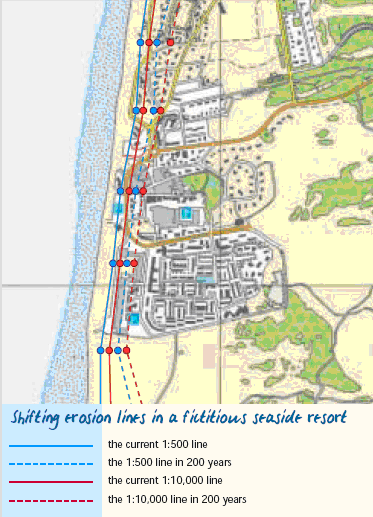
Coastal zone policy in the Netherlands
The primary concern of the Dutch government is to preserve the ‘rest strength’ of the dunes to provide safety against flooding (see figure 5). The rest strength can be defined as the minimum dune volume needed to withstand the design storm conditions (Mulder et al., 2006).
In order to stop the structural erosion of the Dutch coast and hence to provide a sustainable safety level of the dunes, Dutch government decided in 1990 to maintain the coastline at its 1990 position. Around this coastline some natural fluctuations were allowed. The ‘Dynamic Preservation’ policy (CPD 1, 1990) was adopted in which a ‘base coastline’ (BCL) was defined for each 250 m wide coastal section. This BCL relates the coastline position to the ten-year trends in sand volumes in the upper part of the coastal profile, i.e. between dune foot – which is located at around + 3 m Dutch Ordnance Level- and – 5 m Dutch Ordnance Level.
The risk of coastal flooding is expected to increase in the future, because the probability of occurrence of flooding and the socio-economic value in coastal zone are both expected to increase.
Without management interventions, the erosion lines will continue to shift in a landward direction due to the rise in sea level (see figure 2). In addition, in the Netherlands, relative sea level will also rise without climate change-related sea level rise. This is due to the postglacial subsidence of the North Sea basin. Furthermore, climate change may lead to more frequent and more intense storm conditions, which jeopardize dune safety. The effects in terms of socio-economic damage will increase as well, not only as a result of the increased probability of a storm event, but also due to ongoing demographic and socio-economic developments, which will also demand more and more space in the coastal zone. Therefore, it is of great importance to gain more insight in how different socio-economic activities can adapt to the long-term and large-scale natural coastal dynamics. In the Dynamic Preservation policy, large-scale and long-term morphological developments are neglected. Therefore, in 2000, Dutch government decided to adopt a more large-scale approach (CPD 3, 2000), wherein besides maintaining safety on longer temporal scales, spatial quality in the coastal zone has to preserved and -where possible- improved (RIKZ, 2002). Coastal safety policy and safety measures should involve a time horizon of 200 years.
This long-term and large-scale approach was elucidated in NSS (2004), in which the Coastal Foundation Zone concept was introduced, the Coastal Foundation Zone being defined as the area between the dunes and the – 20 m depth contour (figure 4). In this area, the sediment budget should be maintained. The primary method to maintain the sediment budget is by means of sand nourishments.
Preservation of the Coastal Foundation Zone (CFZ) at the largest scale, provides the boundary conditions for preservation of the BCL on smaller temporal and spatial scales. The BCL in turn, provides the boundary conditions for safety of the dunes, i.e. maintaining the rest strength. Therefore, preservation of the CFZ will provide long-term safety of the dune area. These three scale levels in coastal management practices are indicated in figure 5.
For all dunes along the Dutch coast erosion line positions for the next 50, 100, 150 and 200 years have been determined (RIKZ, 2002) (figure 3).
Figure 4. The coastal foundation zone (Mulder et al., 2006)
Figure 5. Scales in coastal zone management (Modified after: Mulder et al., 2006)
In addition to maintenance of the BCL, different measures can be taken to maintain a predefined dune safety level. These measures include planting of grasses and/or placement of sand fences to stabilize the dunes and even complete fixation or remodeling of dunes (Arens and Wiersma, 1994).
All sea defense structures in the Netherlands currently meet the safety standards. Sea defense structures which must be reinforced in the coming 200 years are called weak links. In these areas, a ‘reservation zone’ must be retained, to limit further socio-economic developments.
References:
Bickerstaff, K. (2004). Risk perception research: socio-cultural perspectives on the public experience of air pollution, Environment International, 30, 827-840
CPD 1 (1990). Kustverdediging na 1990, 1st Coastal Policy Document, Ministry of Transport, Public Works and Water Management, 65 p.
CPD 3 (2000). Traditie, Trends en Toekomst, 3rd Coastal Policy Document, Ministry of Transport, Public Works and Water Management, pp. 122
Jonkman, S. N., van Gelder, P. H. A. J. M., Vrijling, J. K. (2003). An overview of quantitative risk measures for loss of life and economic damage, Journal of Hazardous Materials, A99, 1-30
Loucks, D. P. and van Beek, E. (2005). Water Resources Systems Planning and Management An Introduction to Methods, Models and Applications, UNESCO and WL|Delft Hydraulics, ISBN 92-3-103998-9
Mulder, J.P.M., Nederbragt, G., Steetzel, H.J., van Koningsveld, M., Wang, Z.B. (2006). Different implementation scenarios for the large-scale coastal policy of the Netherlands, proceedings ICCE2006
NSS (2004). National Spatial Strategy; creating space for development. Interdepartementale Projectgroep Nota Ruimte, Ministeries van VROM, LNV, VenW en EZ, The Hague, The Netherlands
Renn, O. (1998). The role of risk perception for risk management, Reliability Engineering and System Safety, 59, 49-62
RIKZ (2002). Towards an Integrated Coastal Zone Policy, Policy agenda for the coast, Rijkswaterstaat, National Institute for Coastal and Marine Management/RIKZ, pp. 48
RWS (2005). Veiligheid Nederland in Kaart, Hoofdrapport onderzoek overstromingsrisico’s, of Transport, Public Works and Water Management
Taal, M. Mulder, J., Cleveringa, J., Dunsbergen, D. (2006). 15 years of coastal management in the Netherlands, Policy; Implementation and Knowledge Framework, Rijkswaterstaat, National Institute for Coastal and Marine Management/RIKZ,
TAW (1995). Basisrapport Zandige Kust, Behorende bij de Leidraad Zandige Kust, ISBN 90-36-93-704-3, pp. 507 TAW (2002). Leidraad Zandige Kust, ISBN 90-369-5541-6, pp. 224
Vrijling, J.K., Van Hengel, W., Houben, R.J. (1998). Acceptable risk as a basis for design, Reliability Engineering and Systems Safety, 59, 141-150
Authorship: written by L.M. Bochev-van der Burgh
